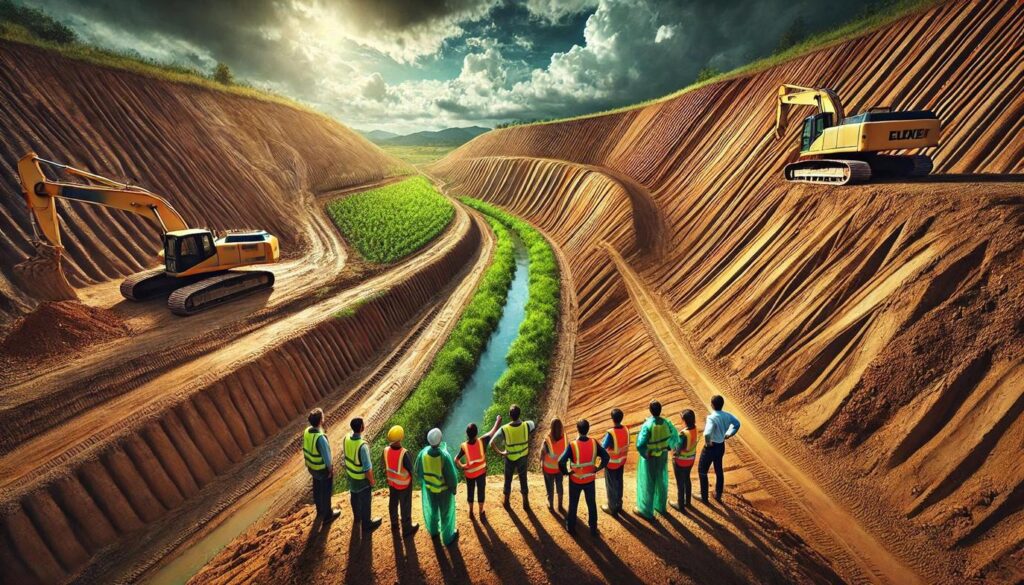Erosion has long been a challenge for land management, affecting agriculture, construction projects, and natural landscapes. Uncontrolled soil movement can result in the loss of fertile land, damage to infrastructure, and disruption of ecosystems. To mitigate these effects, strategic erosion control measures are essential, and excavation plays a significant role in these strategies.
Effective erosion control relies on excavation to shape land, improve water management, and stabilize vulnerable areas. Through proper planning and execution, excavation can transform landscapes, reducing soil loss and protecting both natural and developed environments.
Core Applications of Excavation in Erosion Control
1.Shaping Land to Reduce Runoff
Excavation enables the careful reshaping of land to manage water flow and reduce surface runoff. Utilizing local excavation services can enhance the precision and efficiency of these efforts. By grading slopes and creating terraces, soil movement caused by rainfall can be significantly minimized. Terracing and contouring redirect water, preventing it from gathering speed and carrying soil away.
Excavated channels or swales can be constructed to guide water toward safe drainage areas, reducing the risk of gullying and other forms of erosion. Properly designed excavated landforms provide a foundation for vegetation growth, which further stabilizes the soil and enhances water absorption. Over time, these measures create a more resilient landscape that can withstand heavy rainfall without significant soil loss.
2.Creating Retention and Detention Structures
Excavation is essential for constructing retention ponds, detention basins, and other water-holding structures that help control erosion. By excavating depressions or basins, water can be captured and slowly released, reducing the velocity of surface runoff. Slower water flow decreases the force acting on soil particles, preventing them from being washed away.
Excavation also facilitates the installation of drainage systems beneath these structures, enhancing their efficiency. These water management solutions are particularly crucial in urban areas, where impervious surfaces significantly increase runoff rates. When combined with vegetation and other erosion control techniques, excavated retention areas significantly reduce soil displacement and protect downstream environments.
3.Stabilizing Slopes and Embankments
Unstable slopes and embankments are prone to landslides and severe erosion, posing risks to human settlements and natural habitats. Excavation helps in stabilizing these areas by removing loose or excess material and creating structured slope profiles. Key engineering techniques include:
- Cut-and-Fill Methods: Mitigate steep gradients, distribute soil evenly, and reinforce weak zones.
- Terracing: Create level steps on a slope to slow water flow.
- Retaining Walls: Provide structural support, often integrated with natural vegetation or bioengineering techniques to enhance slope stability.
Carefully planning excavation activities can transform erosion-prone areas into secure and stable landforms, preventing sudden soil loss and safeguarding both infrastructure and ecosystems.

4.Facilitating Vegetation Growth
While vegetation is one of the most effective natural erosion control mechanisms, excavation is instrumental in preparing the land for planting. Excavation removes debris, rocks, and compacted soil layers, creating a suitable seedbed for grasses, shrubs, and trees. Properly graded and loosened soil allows roots to penetrate more deeply, anchoring the soil and reducing susceptibility to erosion.
Excavated channels and terraces can also be lined with vegetation to create natural buffers against water flow. Additionally, excavated areas designated for planting can incorporate soil amendments and mulching to enhance fertility and improve moisture retention. By integrating excavation with planting strategies, erosion control efforts are significantly strengthened.
5.Enhancing Drainage and Water Management
To prevent erosion, excavation is used to install critical drainage systems, such as French drains, culverts, and subsurface pipes. By excavating trenches and channels, water can be directed away from vulnerable areas, reducing saturation and soil movement. Excavation also enables the creation of infiltration zones, where water can be absorbed naturally, thereby reducing the volume of runoff and associated erosion risks.
In agricultural and construction sites, carefully designed excavated drainage systems protect both soil and structures from water damage. By controlling how water moves across a landscape, excavation helps minimize erosion while maintaining ecological balance.
6.Supporting Infrastructure Protection
Roads, bridges, and other infrastructure are often at risk from soil erosion, especially in areas with steep slopes or heavy rainfall. Excavation is essential in preparing stable foundations and protective embankments around these structures.
Removing unstable soil and creating level bases, excavation reduces the risk of foundation erosion and structural failure. Retaining walls, gabions, and other erosion prevention measures can be incorporated into excavated zones to further safeguard infrastructure.
Excavation also allows for ongoing maintenance and adjustment of drainage and slope management systems, ensuring long-term erosion control. The integration of excavation with structural and natural solutions creates a comprehensive approach to preserving both human-made and natural environments.
7.Enabling Sediment Control
Sediment carried by erosion can damage waterways, reduce water quality, and harm aquatic habitats. Excavation supports sediment control by creating catchment areas, sediment traps, and filtration zones, thereby reducing the impact of erosion. Excavated basins or ponds capture soil particles before they reach streams and rivers, while trenches and channels can slow water flow and allow sediment to settle.
These excavated features are often used in conjunction with silt fences, riprap, or vegetative buffers to enhance sediment retention and control. By managing sediment through excavation, erosion control measures not only protect soil on-site but also prevent downstream environmental degradation. This holistic approach ensures sustainable management of land and water resources.

The Foundation of Lasting Land Stability
Excavation is an indispensable tool in the proactive management of land and water resources. By strategically reshaping landscapes, constructing vital water retention systems, and preparing stable ground for vegetation, excavation provides the essential framework for durable erosion control.
Deliberate interventions move beyond reactive fixes, creating resilient environments that can effectively manage runoff, protect infrastructure, and preserve valuable topsoil. The result is a landscape that is not only protected from immediate threats but is also better equipped to maintain its integrity against future environmental pressures.
Ultimately, the successful implementation of these measures underscores the importance of professional planning and execution. Properly managed excavation projects do more than just prevent soil loss; they contribute to healthier ecosystems, safeguard human developments, and support sustainable land use for years to come. By integrating excavation into a holistic erosion control plan, we ensure the long-term health and stability of both our natural and built environments.
Frequently Asked Questions About Excavation and Erosion
What Are the Most Common Excavation Techniques for Erosion Control?
The most common techniques include grading to create gentler slopes, terracing to break up long slopes into shorter, level steps, and creating swales or channels to direct water flow. Cut-and-fill methods are also used to stabilize steep embankments by redistributing soil.
Is Excavation Environmentally Disruptive?
While any land-altering activity has an impact, professionally planned excavation for erosion control is designed to be a net positive. It prevents large-scale, uncontrolled soil loss and sediment pollution in waterways. The process is often paired with revegetation and other bioengineering techniques to restore and enhance the local ecosystem.
How Does Excavation Help on Construction Sites?
On construction sites, excavation is critical for creating stable building pads, grading for proper drainage away from structures, and constructing sediment control measures like detention basins. These actions prevent costly damage to new infrastructure and stop sediment from leaving the site and polluting nearby water sources.
Can Excavation Alone Stop Severe Erosion?
Excavation is the foundational step, but it is most effective when used as part of an integrated system. For severe erosion, excavation is typically combined with other measures such as installing retaining walls, planting deep-rooted vegetation, and using erosion control blankets or riprap to create a comprehensive and resilient solution.




